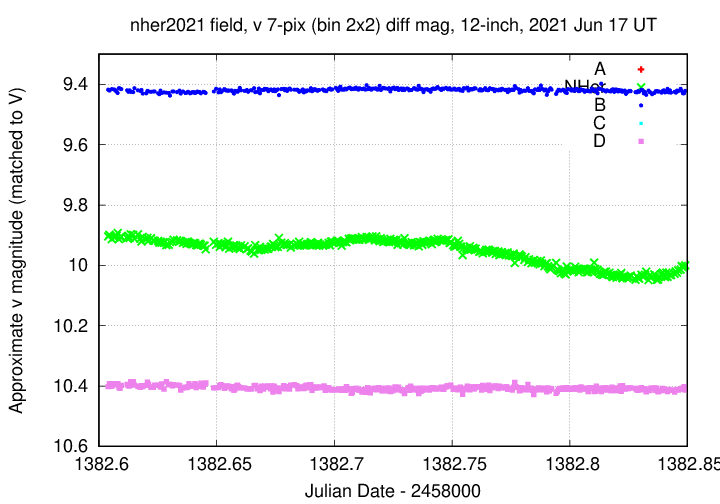
Note added 6/24/2021: I've recalibrated the photometry to use a different reference star. The graphs haven't changed, but the datafile at end of page now has the recalibrated data.
On the night of Jun 16/17, 2021, under good conditions, I acquired images of a new target: Nova Her 2021. One can find information about it at
Archival photometry of the object in quiescence shows a photometric variability with a period of 8.4 minutes ... and my observations show that same period during its bright phase!
This object was discovered by Seiji Ueda (Kushiro, Hokkaido, Japan) on 2021 June 12.537 UT. It rose quickly, then fell quickly.
The main setup was:
Notes from the night:
The object is located at
RA = 18:57:30.95 Dec = +16:53:39.6 (J2000)
A chart of the field is shown below. The size of the chart is about 31 x 26 arcminutes.

I've marked the location of several comparison stars as well. See
I'll use star "E" to shift my instrumental magnitudes to the V-band scale. It has a V-band magnitude (according to AAVSO chart X26675JQ) of 12.221, and (B-V) = 0.608.
The sky value shows no evidence for clouds -- good!

The FWHM was pretty steady, but had a large scatter (in large part due to trailing)

Using aperture photometry with a radius of 7 pixels in a V filter (binned 2x2, each pixel is 1.24 arcsec, so a radius of 8.7 arcsec), I measured the instrumental magnitudes of a number of reference stars and the target. Following the procedures outlined by Kent Honeycutt's article on inhomogeneous ensemble photometry, I used all stars available in each image to define a reference frame, and measured each star against this frame.
Sigma-vs-mag plots show that the floor was about 0.007 mag with a 30-second exposures. The brightest star, "A", is slightly saturated; the second high point is the target.

Most of the changes in image-to-image zero-point are due to trailing; I discarded all images with an zeropoint of more than 10.40.

Here is the light curve of the object and several field stars in the V filter; I've shifted the instrumental magnitudes so that star "E" = 000-BMD-913 on AAVSO chart X26675JQ has the value given by AAVSO as its V-band magnitude.


There are clear variations on top of the slow fading trend of Nova Her 2021. Using the Periodogram tool at the NASA Exoplanet Archive, I computed the power spectrum of these measurements. There are peaks at periods of 0.002792 and 0.00562 days, which correspond to 4.02 and 8.09 minutes.

I have submitted these measurements to the AAVSO.
You can download my measurements below. A copy of the header of the file is shown to explain the format.
# Measurements of Nova_Her_2021 made at RIT Obs, UT 2021 Jun 17, # in good conditions, # by Michael Richmond, # using Meade 12-inch LX200 and ATIK 11000. # Exposures 30 seconds long, v filter. # Tabulated times are midexposure (FITS header time - half exposure length) # and accurate only to +/- 1 second (??). # 'mag' is a differential magnitude based on ensemble photometry # using a circular aperture of radius 7 pix = 8.8 arcseconds. # which has been shifted so AAVSO 000-BMD-913 has mag=12.221 # which is its V-band magnitude according to AAVSO. # # UT_day JD HJD mag uncert Jun17.10391 2459382.60391 2459382.60811 10.117 0.008 Jun17.10442 2459382.60442 2459382.60862 10.112 0.008 Jun17.10543 2459382.60543 2459382.60963 10.126 0.008
Last modified 6/24/2021 by MWR.